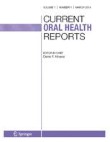
Medicine RSS-Feeds by Alexandros G. Sfakianakis,Anapafseos 5 Agios Nikolaos 72100 Crete Greece,00302841026182,00306932607174,alsfakia@gmail.com
Πληροφορίες
Κυριακή 19 Ιανουαρίου 2020
The Role of the Oral Healthcare Team in Identification of Type 2 Diabetes Mellitus: A Systematic Review
The Role of the Oral Healthcare Team in Identification of Type 2 Diabetes Mellitus: A Systematic Review:


Αναρτήθηκε από
Medicine by Alexandros G. Sfakianakis,Anapafseos 5 Agios Nikolaos 72100 Crete Greece,00302841026182,00306932607174,alsfakia@gmail.com,
στις
10:40 μ.μ.

Ετικέτες
00302841026182,
00306932607174,
alsfakia@gmail.com,
Anapafseos 5 Agios Nikolaos 72100 Crete Greece,
Medicine by Alexandros G. Sfakianakis,
Telephone consultation 11855 int 1193
Εγγραφή σε:
Σχόλια ανάρτησης (Atom)
Αρχειοθήκη ιστολογίου
-
►
2023
(366)
- ► Φεβρουαρίου (184)
- ► Ιανουαρίου (182)
-
►
2022
(2814)
- ► Δεκεμβρίου (182)
- ► Σεπτεμβρίου (213)
- ► Φεβρουαρίου (264)
- ► Ιανουαρίου (262)
-
►
2021
(3815)
- ► Δεκεμβρίου (229)
- ► Σεπτεμβρίου (276)
- ► Φεβρουαρίου (64)
-
▼
2020
(5754)
- ► Δεκεμβρίου (401)
- ► Σεπτεμβρίου (365)
- ► Φεβρουαρίου (754)
-
▼
Ιανουαρίου
(894)
-
▼
Ιαν 19
(109)
- Medicine by Alexandros G. Sfakianakis,Anapafseos 5...
- MDPI
- MDPI
- MDPI
- MDPI
- MDPI
- MDPI
- Postoperative oscillatory brain activity as an add...
- Efficacy of sequential radiation and chemotherapy ...
- Imaging glioma biology: spatial comparison of amin...
- Quantifying the effects of absorbed dose from radi...
- Perioperative EOX in D2 Gastrectomy
- The Degradation of Phenanthrene, Pyrene, and Fluor...
- Association between household food insecurity and ...
- The Role of the Oral Healthcare Team in Identifica...
- The Oral Microbiome and Lung Diseases
- Could Vitamin D Influence Risk for Periodontal Dis...
- Molecular characterization of multidrug-resistant ...
- Causes of fever in pregnant women with acute undif...
- Evaluation of EUCAST rapid antimicrobial susceptib...
- Evaluation of serological diagnostic tests of huma...
- piRNAs: biogenesis and their potential roles in ca...
- Notch signaling patterns head horn shape in the bu...
- Impact of Tai Chi Yuttari-exercise on arterioscler...
- Importance of Distal Sealing During Endovascular A...
- Laser ablation of posterior nasal nerves for rhini...
- Clinical frailty independently predicts early mort...
- Alda-1, an Aldehyde Dehydrogenase 2 Agonist, Impro...
- Hyaluronic Acid Gel Injections in the Subcutis
- Randomised oral stimulation and exclusive breastfe...
- Midfacial Clefting.
- Perception and Acoustic Studies of Vowel Intelligi...
- Vaccines and immunology.
- Oral and maxillofacial cancer in pediatric patients
- Efficacy of melatonin for auditory brainstem respo...
- Female caregivers talk more to 18-56-months-old ch...
- Does delayed initiation of adjuvant chemotherapy f...
- The role of radioactive iodine in the management o...
- Elevated eosinophil level predicted long time to n...
- Elevated eosinophil level predicted long time to n...
- Novel cancer therapies for advanced cutaneous mela...
- Long non-coding RNA ARAP1-AS1 promotes tumorigenes...
- Effects of propofol on colon cancer metastasis thr...
- Phase 1 Fractional Dose-Escalation Study of Equipo...
- Cutaneous plasmacytosis and multinucleate cell ang...
- Pituitary Adenoma Concomitant with Chiari I Malfor...
- Thyroid neoplasm evaluation.
- Superficial Femoral Artery Interposition Graft for...
- Meta-analysis of routine calcium/vitamin D3 supple...
- Sclerotherapy for Venous Malformations of Head and...
- Alternative Applications of Trans-Oral Robotic Sur...
- The Influence of Met Receptor Level on HGF-Induced...
- Impaired Glycolysis Promotes AlcoholExposure-Induc...
- B cells and tertiary lymphoid structures promote i...
- Diagnostic challenges in malignant tumors of nasal...
- Labial hydatid cyst - A rare entity.
- Meta-analysis on risk factors of squamous cell car...
- Inhibition of Carbonyl Reductase 1 Enhances Metast...
- In silico analysis of the prognostic value of FAS ...
- Diabetes and its Potential Impact on Head and Neck...
- A Completely Unique Branching Pattern of the Facia...
- Patient-reported Aesthetic Satisfaction following ...
- Effective Continuous Positive Airway Pressure Chan...
- Draf IIB with superior septectomy: finding the "mi...
- Double-blinded randomized controlled trial to eval...
- A Novel Tool for Nasal Polyp Investigation: An Ex ...
- Characterizing Brain Network Topology in Cervical ...
- Stem Cell-Induced Inflammation in Cholesteatoma is...
- Dual-energy spectral CT quantitative parameters fo...
- Resident Education in Laryngeal Stroboscopy: Part ...
- Hearing loss through apoptosis of the spiral gangl...
- Facial nerve and chorda tympani schwannomas: Case ...
- Prevention of peridural adhesions in spinal surger...
- High CXCR4 expression in adenoid cystic carcinoma ...
- Carotid intimal sarcoma causing stroke and intracr...
- Melanoblast transcriptome analysis reveals pathway...
- Three-Dimensional Printing of the Nasal Cavities f...
- Does Intravenous Contrast Improve the Diagnostic Y...
- Effect of Omega-3 Supplementation in Patients With...
- The repertoire of tumor-infiltrating lymphocytes w...
- Modified facelift approach for posterior segmental...
- Multimodal Therapy for Sinonasal Malignancies: Upd...
- Classifying Neck Lymph Nodes of Head and Neck Squa...
- A 12-channel flexible receiver coil for accelerate...
- Soft Tissue Special Issue: Giant Cell-Rich Lesions...
- Soft Tissue Special Issue: Imaging of Bone and Sof...
- Soft Tissue Special Issue: Adamantinoma-Like Ewing...
- Soft Tissue Special Issue: Myoepithelial Neoplasms...
- Soft Tissue Special Issue: Skeletal Muscle Tumors:...
- Soft Tissue Special Issue: Fibroblastic and Myofib...
- Soft Tissue Special Issue: Selected Topics in the ...
- Soft Tissue Special Issue: Perivascular and Vascul...
- The Outcome of Early Ablative Fractional Laser Tre...
- Surgical treatment of epiglottis collapse in obstr...
- Streamlining care in cystic fibrosis: survey of ot...
- The Sensor Technology and Rehabilitative Timing (S...
- Decreased DNA Damage Repair in Response to Targete...
- Casticin elicits inflammasome-induced pyroptosis t...
- A Cross-Sectional Study of Caregiver Perceptions o...
- Amateur Music Theatre Singers' Perceptions of thei...
-
▼
Ιαν 19
(109)
-
►
2019
(146)
- ► Δεκεμβρίου (19)
- ► Σεπτεμβρίου (54)

Δεν υπάρχουν σχόλια:
Δημοσίευση σχολίου